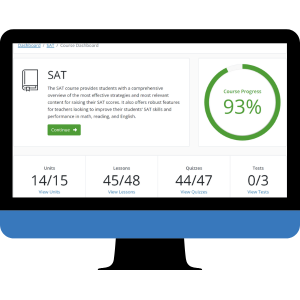The Digital PSAT® and SAT®
What You Need to Know About the Tests and How Method Learning is Preparing for Them
The Digital SAT® presents a major leap forward in college admissions standardized testing, not only because it is computer-based, but also because it is an adaptive exam. While this is a significant departure from the classic test-booklet-and-bubble-sheet model, it is hardly unprecedented: several graduate-level admissions exams (e.g., the GRE and GMAT) have for years been computer-based and adaptive. According to psychometricians—professionals who specialize in accurate test design, administration, and scoring—adaptive tests more efficiently and effectively gauge student performance, arriving at accurate scores in fewer questions over less testing time. Shifting to a digital test format will also increase test security, expedite scoring, increase the number of testing opportunities, and, most importantly, improve students’ testing experience.

Quick Facts for U.S.-based students:
- The Fall 2023 PSAT® will be digital.
- Through December 2023, the SAT® will remain in its current, paper-based form; the March 2024 SAT® will be the first digital administration of the test. Thus, students in the class of 2025 will be the first to experience the digital PSAT® and SAT® in large numbers.
- Structure. The digital SAT®’s structure comprises two sections:
- Reading and Writing, which will test reading comprehension, English grammar and structure, and integration of data and text.
- Math, which will test skills in algebra I and II, data analysis and statistics, and to a lesser extent, geometry and trigonometry.
-
- Each section of the digital SAT® will be tested over two consecutive modules.
- Each section of the digital SAT® will be tested over two consecutive modules.
- Though the digital SAT’s question and passage formats will in some cases be significantly different than they are today, the SAT® will continue to test the same set of skills tested on the current, paper-based SAT®.
- Adaptivity. The digital SAT® will be an adaptive exam.
- The digital SAT® is module-level adaptive : based on their performance on the first module of a given section, students will be routed into a second module calibrated for a particular overall level of difficulty. Their scores will depend on both the number of questions answered correctly and the relative difficulty of those questions.
- The adaptive nature of the exam allows it to arrive at accurate scores with fewer questions over less testing time. Indeed, completing the digital SAT® will take roughly 2 hours—one hour less than the duration of the current SAT®.
- The digital SAT® is module-level adaptive : based on their performance on the first module of a given section, students will be routed into a second module calibrated for a particular overall level of difficulty. Their scores will depend on both the number of questions answered correctly and the relative difficulty of those questions.
In mid-2022, the College Board released details of the digital SAT’s content and framework; later in the year, it released initial practice materials, including its new BlueBook software, the platform in which students will take their practice tests and official exams.
Since that time, our content team has pored over the materials, scrutinizing the full range of question types and difficulty, section format, passage presentation, scoring, and more. Through our analysis of the released practice tests and supplementary information, we have developed a deep understanding of what students will be facing. In turn, we’ve taken this information to develop brand new content and strategies for our renowned self-paced test prep platform, Methodize. This content will become available to students and schools this June.
Additional Resources and Information
To access digital SAT® information from the test creator itself, visit the College Board website. There, you’ll find more detail about the exam specifications, test registration, and official practice resources.
We’ve also produced several blog posts analyzing what students can expect to see on the digital SAT®.
Want to learn more about how we can help your students prepare for the digital SAT? Contact us at support@methodlearning.com or call 877-871-7737





